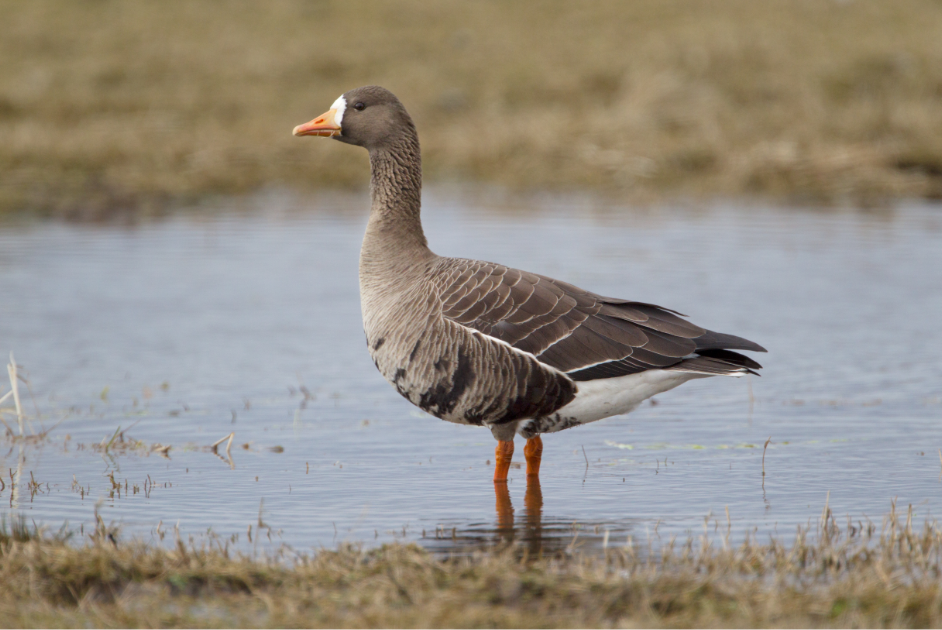By Gareth Thomas, ECHOES Ecologist
THE Greenland White-fronted Goose is a fascinating bird, with nearly its entire population spending the winter in Britain and Ireland. The goose breeds in west Greenland on fertile areas close to the icecap with many lakes and wetlands. It stops off in Iceland both in the spring and autumn on migration. As the temperature drops in the autumn, the bird flies off south to enjoy the milder winters that we have in Britain and Ireland. Large numbers winter in the Wexford Slobs, pretty much opposite us across the Irish Sea. They also like to stay on Islay, a Scottish island. Our birds on the Dyfi Estuary – some with collars showing an identification number – will sometimes wander in the winter. They cross the sea over to Ireland to spend part of the winter in flocks numbering thousands of geese.
The small number of Greenland White-fronted Geese wintering on the Dyfi Estuary are the most southerly flock in Britain. Unfortunately, it is in serious decline, with only around 15 or 20 birds in recent winters. This compares with over 150 birds in the 1990’s. This decline is probably due mainly to poor breeding in Greenland. Very few young birds have been seen in recent times. Poor breeding has been linked to bad summer weather and to competition with Canada geese for the best breeding areas. The link that the Dyfi Estuary flock has shown to larger flocks, gives hope that other Greenland White-fronted Geese will choose to spend the winters here. Last November, an additional flock of twelve birds arrived with young birds. Unfortunately, they did not stay long and were last seen heading west towards the sea.
I have had the privilege of observing this flock of geese on the Dyfi Estuary for five years now, previously in my role as surveyor for the RSPB and Natural Resources Wales, and currently as part of the field ecology team working for the ECHOES project.
The ECHOES project is collecting information on what the geese are feeding on and this involves collecting what they produce for analysis. As there are numerous Canada geese feeding where the White-fronts feed, I have been closely recording where they feed and of course, where they go to the toilet!
My day starts pre-dawn walking out to a viewpoint, to hopefully spot the geese leaving their roosting site. The geese like to roost somewhere safe on the estuary, or close to water, and in the half light of pre-dawn they can be seen flying to their feeding haunts for the day. These geese minimise the amount of time spent flying about and may only fly twice each day (hence the necessity to set the alarm early!).
After the sun sets, the geese will return to their roost for the night. It can often be quite dark when this happens, presumably the geese are keen to fill themselves up with food for the long night ahead. A still evening helps to spot them as they may call. Their call has a musical or laughing quality to it and adds to the sounds of the estuary at this time of the day, with Curlew and Lapwing moving off as well.
With the geese safely out of the way, it is time to help the other researchers locate the goose poo. Fortunately, it’s relatively easy to distinguish Canada and White-front faecal material even in the dark. A smaller bird produces smaller poo!
Photo: Edmund Fellowes
The ECHOES project
The ECHOES project is funded by the INTERREG Ireland Wales Programme. The project was established in December 2019 and had its official launch in July 2020. It will run until June 2023. The ambition with the project is to map out the habitats of two overwintering bird species in Ireland and Wales: Eurasian Curlew and Greenland White-fronted Geese. These birds are in serious decline but can still be found along the Irish Sea coastlines.
By learning more about these birds’ habitats, ECHOES will provide research that can help site managers and landowners along the coast to make informed decisions on how to preserve these species in the future – especially with rising sea levels and a changing climate in mind. ECHOES is also developing digital tools for this very purpose. These tools will include a variety of data, including climate change projections, to help predicting how selected habitats will change over time.
Stakeholder engagement is a vital part of the project. For the duration of the project, ECHOES will reach out to stakeholders in coastal areas in the INTERREG programme area. Several awareness raising initiatives, such as talks and workshops, will take place in this time. The focus will be on climate change and how it is likely to impact coastal bird habitats, and indirectly, how it might affect people and communities along the coast.
If you would like to know more about the ECHOES project, see: echoesproj.eu, and subscribe to our newsletter.
You can also connect with the ECHOES project on Facebook and Twitter, or email: info@echoesproj.eu
